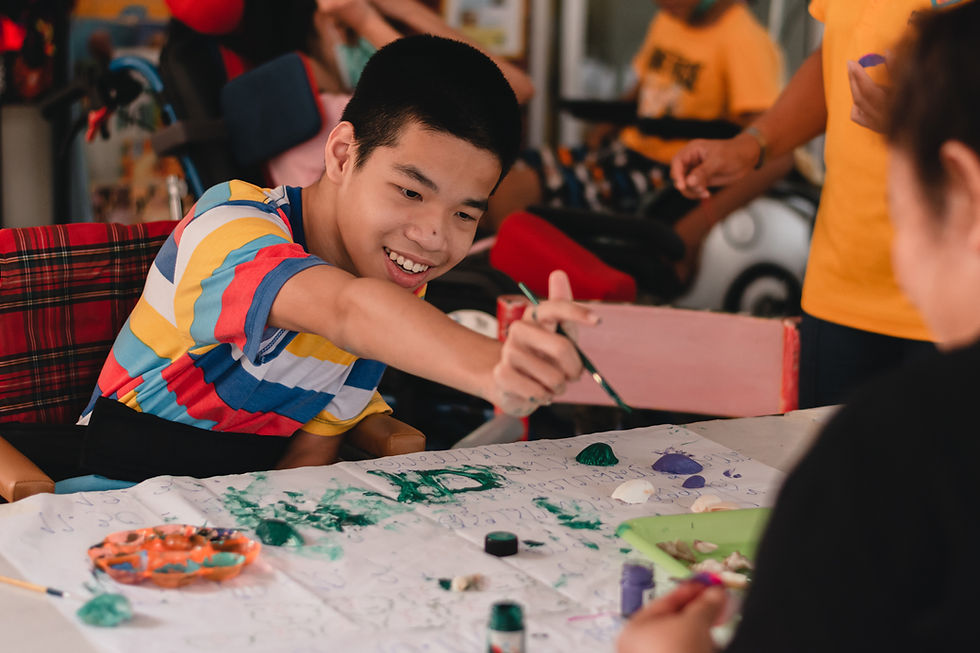Understanding Neurodiversity
- Rachel Medlock
- Mar 8, 2023
- 3 min read
Updated: Oct 4, 2024

At The Giggle Garden, we’re still learning - just like many of you; navigating what it means to support a neurodivergent child while continuing to learn and evolve our language and understanding each and every day. Whether you're a parent to a neurodivergent child or a friend or family member wanting to better support and understand your loved one, we’re here to help you take those first steps. Let’s explore what neurodiversity really means.
What Is Neurodiversity?
The term neurodiversity is used to describe the natural diversity of human brains. Just as biodiversity captures the variety of plant and animal life, or multiculturalism captures the varieties of cultures in our world, neurodiversity explains the variety of human minds. Every brain is wired differently, and these differences are a beautiful part of what makes us human. Some children think, learn, and experience the world differently, and these differences are all part of neurodiversity.
Neurodivergent vs. Neurotypical
Neurodivergent refers to a person whose brain functions in ways that are different from what society typically expects. Examples include autistic individuals, people with ADHD, and those with dyslexia. The word "neurodivergent" celebrates that these differences are natural, not something to be "fixed."
Neurotypical refers to a person whose brain functions in ways that align with what society deems typical. It’s not a good or bad label - just a descriptor for those who experience the world in a statistically common way.
Why Language Matters
Language is powerful, and the words we use to describe our children shape not only how others see them but how they see themselves. At The Giggle Garden, we use identity-first language, meaning we say "autistic person" rather than "person with autism." This is because many in the neurodivergent community feel that their neurodivergence is an important part of their identity.
Instead of viewing neurodivergence as a "condition" or "something to overcome," we embrace it as part of the rich variety of human experience. When we say "neurodivergent child," we’re saying that this difference is a meaningful part of who they are.
Key Terms You Should Know
Neurodiverse: This term describes a group of people with different kinds of brains, including both neurotypical and neurodivergent individuals. For example, a classroom full of children with various ways of thinking is neurodiverse.
Neuro-minority and Neuro-majority: These terms help explain the differences in population. Neuro-minority refers to those who think differently from the majority of people. Currently, neurodivergent people make up the neuro-minority. Meanwhile, neuro-majority describes those with statistically typical brain functions - usually neurotypical people.
Understanding these terms can help you navigate conversations about your child and advocate for their needs. It allows you to speak clearly and confidently about neurodiversity and to help others understand and appreciate the uniqueness of your child.
Why This Matters for Our Kids
It’s estimated that "1 in 40 Australians are autistic" (Source: Aspect). When we use language that celebrates differences instead of pathologising them, we help create a world where all children can thrive. Neurodivergence is not something to be hidden or ashamed of; it’s a unique way of experiencing the world. For children, feeling understood and accepted is fundamental to their well-being.
Neurodiversity isn’t just about conditions like autism or ADHD; it’s about celebrating how all of us, neurotypical and neurodivergent alike, think differently, experience joy differently, and contribute to the world in our own ways.
For many parents, starting to understand neurodiversity can be like opening a door to a whole new perspective. It helps us not only understand our own children but also foster empathy for other children and families. Creating a community where neurodivergence is seen as valuable helps our children to feel accepted, supported, and celebrated for who they truly are.
Let’s work together to foster an inclusive environment, starting with understanding and celebrating neurodiversity. Because every mind matters, and every child deserves to feel seen, valued, and loved.
.png)



Comments